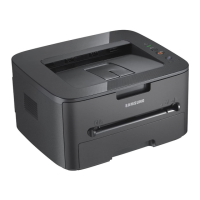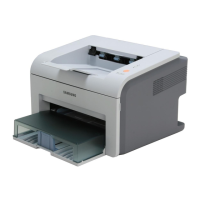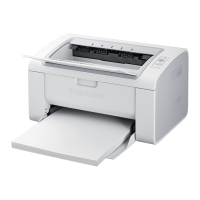Network setup_33
Your machine appears on the Printer List, and is set as the default
machine.
18. Click Add.
If the printer driver does not work properly, uninstall the driver and
reinstall it.
Follow steps below to uninstall the driver for Macintosh.
a) Make sure that the machine is connected to your computer and
powered on.
b) Insert the supplied software CD into your CD-ROM drive.
c) Double-click CD-ROM icon that appears on your Macintosh
desktop.
d) Double-click the MAC_Installer folder.
e) Double-click the Installer OS X icon.
f) Enter the password and click OK.
g) The Samsung Installer window opens. Click Continue.
h) Select Uninstall and click Uninstall.
i) When the message which warns that all applications will close
on your computer appears, Click Continue.
j) When the uninstall is done, click Quit.
Linux
Install Linux Driver
1. Make sure that the machine is connected to your network and
powered on. Also, your machine’s IP address should have been set.
2. From the Samsung website, download the Unified Linux Driver
package to your computer.
3. Right click the Unified Linux Driver package and extract the
package.
4. Double click cdroot > autorun.
5. The Samsung Installer window opens. Click Continue.
6. The Add printer wizard window opens. Click Next.
7. Select Network printer and click Search button.
8. The Printer’s IP address and model name appears on list field.
9. Select your machine and click Next.
10. Input the printer description and Next
11. When the add printer is done, click Finish
12. When the install is done, click Finish
Add network Printer
1. Double-click the Unified Driver Configurator.
2. Click Add Printer…
3. The Add printer wizard window opens. Click Next.
4. Select Network printer and click the Search button.
5. The printer’s IP address and model name appears on list field.
6. Select your machine and click Next.
7. Input the printer description and Next
8. When the add printer is done, click Finish.
IPV6 CONFIGURATION
TCP/IPv6 is supported properly only in Windows Vista or higher.
If the IPv6 network seems to not be working, set all the network setting
to the factory defaults and try again. (See "Restoring factory default
settings" on page 31.)
To use the IPv6 network environment, follow the next procedure to use the
IPv6 address:
The machine is provided with IPv6 feature on.
1. Connect your machine to the network with a network cable.
2. Turn on the machine.
3. Print a Network Configuration Report from the machine’s control
panel that will check IPv6 addresses.
4. Select Start > Control Panel > Hardware and Sound > Printers > Add
Printer.
5. Click Add a local printer on the Add Printer windows.
6. Follow the instruction on the window.
If the machine does not work in the network environment, activate
IPv6. Refer to the next section followed by.
Printing network configuration report
You can print a Network Configuration Report from the machine's control
panel that will show the current machine’s network settings. This will help
you to set up a network and troubleshooting problems.
To print the report:
In ready mode, press and hold the (cancel button) for about 5 seconds.
You can find your machine’s MAC address and IP address.
For example:
• MAC Address : 00:15:99:41:A2:78
• IP Address : 192.0.0.192
Setting IPv6 addresses
Machine supports following IPv6 addresses for network printing and
managements.
• Link-local Address: Self-configured local IPv6 address. (Address starts
with FE80.)
• Stateless Address: Automatically configured IPv6 address by a
network router.
• Stateful Address: IPv6 address configured by a DHCPv6 server.
• Manual Address: Manually configured IPv6 address by a user.
Manual address configuration
1. Start a web browser such as Internet Explorer that supports IPv6
addressing as a URL. (See "Using SyncThru™ Web Service" on
page 24.)
For IPv4, enter the IPv4 address (http://xxx.xxx.xxx.xxx) in the
address field and press the Enter key or click Go.
2. When the SyncThru™ Web Service window opens, click Network
Settings.
3. Click TCP/IP.
4. Enable the Manual Address In the TCP/IPv6 section.
5. Select the Router Prefix and click the Add button, then the router prefix
will automatically be entered into the address field.
Enter the rest of address. (ex: 3FFE:10:88:194::AAAA. “A” is the
hexadecimal 0 through 9, A through F.)
6. Click the Apply button.

